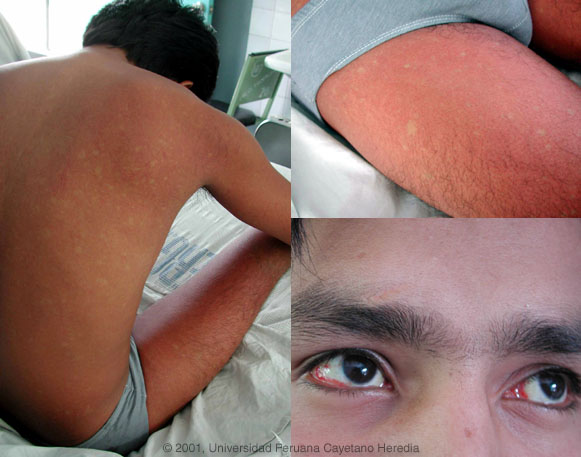| Discussion: Dengue infections range from asymptomatic through a range of clinical manifestations to death. The incubation period of this flavivirus is normally 3-7 days from the time of the infective bite of the Aedes mosquito. Typical dengue fever is manifest by frontal headache, retro-orbital pain, muscle and joint pain, nausea vomiting and rash. Fever lasts 5-7 and may be biphasic or saddleback but this is not the norm. An early flushlike rash usually wanes after a few days and may be replaced by a macular or morbilliform rash. A late petechial rash may also occur. Virus may be isolated from blood during the first 5 days only. IgM elevations don't occur until 5 days or more so a sample taken earlier may be negative. Four-fold elevations of IgG on acute and convalescent serum may be required to confirm diagnosis.
A diagnosis cannot be made on clinical findings alone. Malaria, other arboviruses, leptospirosis, rickettsial disease, measles, or typhoid may present similar findings and need to be tested for. Leptospira IgM was negative in this patient. Mild elevations of liver function tests as found here are typical of dengue as well as the other diseases mentioned. If symptoms begin more than 2 weeks after a patient has left an endemic area dengue can be essentially ruled out.
This patient had conjunctival hemorrhage, spontaneous epistaxis, and thrombocytopenia (32K). Does he have Dengue Hemorrhagic Fever? The answer is no, he does not meet the recognized WHO criteria which must include all of 1) fever; 2) hemorrhagic manifestations (or a positive tourniquet test); 3) platelets less than 100K; and 4) one piece of evidence of increased plasma leakage (pleural effusion, ascites, hematocrit increased 20% over normal or drop of 20% with hydration, or hypoproteinemia). Thrombocytopenia often occurs with uncomplicated dengue so that hemorrhage without plasma leakage does not constitute DHF.
A positive tourniquet test occurs in up to 50% of patients with classic dengue and in almost all patients with DHF. A positive tourniquet by itself may be positive with a number of other infections. The test is performed by inflating a blood pressure cuff halfway between systolic and diastolic for 5 minutes and upon release counting the number of petechiae in a 2.5cm x 2.5cm patch below the cuff. Greater than 20 petechiae is considered positive.
An outbreak of dengue at the beginning of 2001 in Tumbes and Piura, the 2 northernmost departments of Peru. All four serotypes of dengue have been identified and a number of cases of Dengue Hemorhagic Fever have been confirmed.
|


